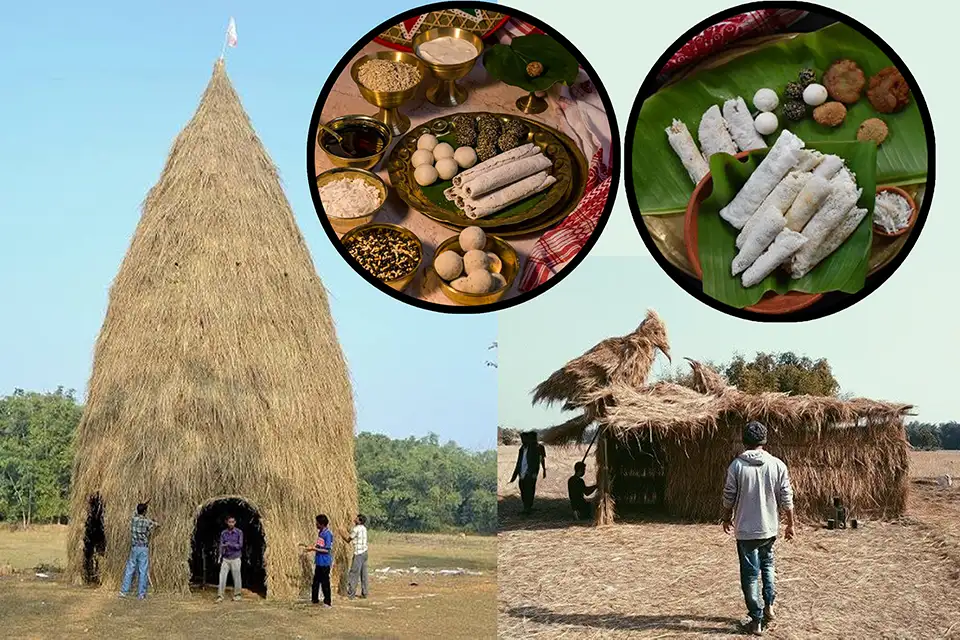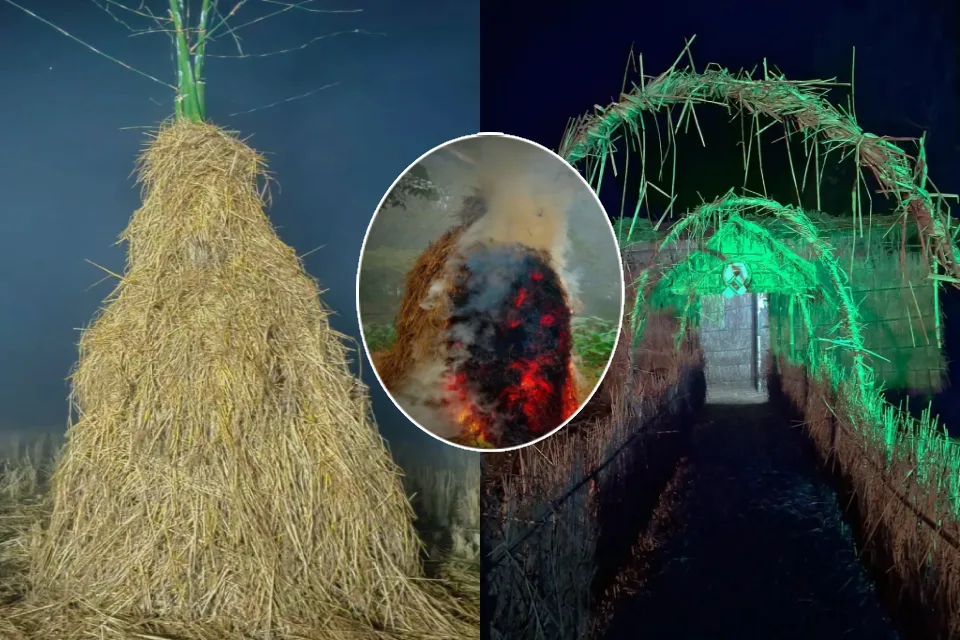Let’s explore how the month of January keeps the people of Assam excited. Explore everything about the festival of harvest- Bhogali Bihu, and its significance in Assamese culture.
Updated on :
Share this post
Magh Bihu, also known as Bhogali Bihu, is an Assamese festival celebration that takes place in mid-January at the intersection of the Assamese months of Puh and Magh, emphasizing its primary characteristic of feasting.
In January, the winter solstice coincides with Bhogali. Although a traditional fire ceremony is closely associated with Bhogali bihu, Uruka, the Bihu eve, is the central event.

Seasonal magnitude of Bhogali Bihu
Assamese winter temperatures often peak in the month of Puh, and the shivering cold begins to lessen after Bhogali Bihu. Thus, at the start of the day of Bhogali Bihu, the warmth of Mezi is very pleasant. Furthermore, in the state’s rural households, the majority of food items become truly accessible throughout the winter months.
During this time of year, milk is most readily available. By eating freshly produced rice, the ducks also gain weight and develop the best flesh. During this time, the majority of veggies also grow in abundance. Before this occasion, a number of unique and indigenous potato varieties are harvested, and people savor them with customary preparations.
Additionally, the best time of year to catch fish from natural water sources such as rivers, streams, and beels is during the winter. As a result, in some locations, fish harvesting from these water sources is done by the community either on Uruka day or the day before. As a result, the rural families can afford to make large contributions for the lavish communal feast on Bhogali Bihu, and they can make a lot of traditional food and sweets.
The Sankranti
Lasting for a week, Bhogali Bihu is the Assamese celebration of Sankranti. Dedicated to Agni, the Lord of Fire, is the Magh Bihu celebration. The Sankranti celebration, however, is devoted to Surya, the Sun Lord, across the rest of India.
On its cosmic journey, the Sun enters Makar Rashi on Makar Sankranti. During the six-month Uttarayana period, it also signifies the sun’s shift. As the day the sun starts its trek north, Makar Sankranti is also known as Uttarayana. Among the twelve Sankranti, Makar Sankranti is regarded as the most important from both an astrological and a religious perspective.
As a result, Makar Sankranti is celebrated with tremendous joy and religious faith in many regions of India on this auspicious day. In addition to Bhogali Bihu, other regional celebrations of Makar Sankranti include Thai Pongal, Haldi Kumkum, Maghe Sankranti, Pedda Pedaga, Suggi, and others.
Significance of Bhogali Bihu
Bhogali Bihu is an expression of gratitude and a rich celebration of tradition. A celebration honoring the fire god and honoring the season’s bountiful harvest. It’s time to escape the daily grind and enjoy this opportunity to express gratitude for the numerous blessings that nature bestows upon us each year. The remaining portion of the Assamese population likes the Bhogali because of its enthusiasm. In Assam, one of the most widespread occupations is agriculture. The people worship and respect Mother Nature and the land.
Rituals of Bhogali Bihu
Nam-prosanga
A group of people sing hymns together, accompanied by the melodious tones of huge cymbals and the beats of kettledrums. Whether performed at the namghar or in homes, the nam-prosanga, or hymn-singing, is a prominent event that takes place during the month of Magh, which is seen to be auspicious for religious activities.
This specific aspect of the Bhogali Bihu celebration is where Vaishnavism’s impact is most noticeable. The spiritual ambiance created by the well-balanced music and devotional chanting captures the diversity of cultures and religions connected to this festival.
Sports and feasting
The integration of diverse sports and traditional games in various regions is an interesting aspect of the Magh Bihu celebration. From wrestling, running, and jumping to the unusual contests of buffalo fighting (moh-juj), egg fighting (kani junj), and bulbuli fighting, these entertaining sports cover a wide range of activities.
During Magh Bihu, the Uruka feasting can be a communal event or a family get-together. The spirit of Bhogali Bihu’s Uruka celebrations is captured in this fusion of music, coziness, and communal food, making it an unforgettable occasion for everyone. By hosting communal feasts and engaging in adventurous activities, all of these events serve to unite the masses and foster a sense of community.
Mezi and Bhela Ghor

Mezi is the most important aspect of celebrating Bhogali Bihu other than feasting. It is a bonfire prototype that is built using wood and bamboo. Mezi is burnt early morning on the day of Bhogali Bihu and the fire is considered auspicious. People pray and seek the warmth of burning Mezi offering prayers to the God of fire. Mezi is a symbolism of burning away of the past and the beginning of a new year.

Meanwhile, Bhela Ghar is a temporary tent made of bamboo and straw to spend the uruka night. The menfolk build it with pure joy and enthusiasm and families enjoy their uruka dinner inside that Bhela Ghar. People also dance and play traditional music inside these tent houses.
Modernization
Assamese people in both rural and urban areas celebrate Bhogali Bihu as a community feast. Nevertheless, there is concern that the present millennium is seeing an increase in the practice of feast celebrations at the family or small group level. It is undoubtedly the result of growing individualism brought on by modernity and prosperity.
The Bhela Ghars, which were constructed by the locals long before Uruka, are common in Assamese communities. These days, they come in a variety of sizes and styles, including cottages, animal forms, and other figurines. Even several competitions are organized to find the most beautiful bhelaghar. Although bhelaghars and Mezis are typically produced in villages, they can now be purchased in urban areas in pre-made forms.
Role of Women
In Assam, the harvest festival of Magh Bihu is celebrated with a strong female presence. For the celebration, women make the traditional dishes pitha, laru, chira, and curd. Pitha preparation is a time for ladies to interact with one another and starts days before the celebration.
Additionally, on the first day of Magh Bihu, also called Uruka or Bihu Eve, women in the village prepare the food for the night feast, known as Bhuj. Many tribal women make rice beers like Chuji, Nam-Lao, and Aapong, which are regional beverages.
Reference: Bihu Festivals: All-inclusive elucidations



